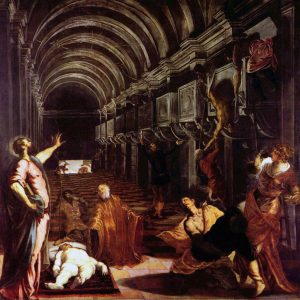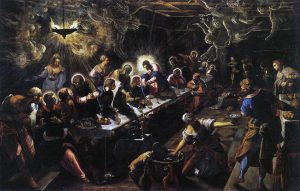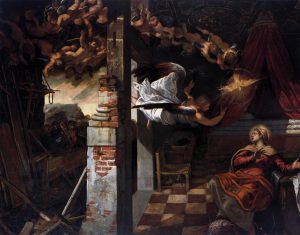Jacopo Robusti, also known as Tintoretto (1519-1594) was a Venetian painter whose works were defined in the Mannerist style by his representation of muscular figures, expressive gestures, and an understanding of perspective. The method in which he painted was bold, energetic, and speedy. He was certainly quick with a brush, resulting him with the nickname Il Furioso. He combined Titian’s handling of colour with Michelangelo’s study of forms and applied it to his skill set. Tintoretto was a lover of drama, the scenes he painted were theatrical, this style would later affect the Baroque period.

This is a great example of Tintoretto’s early work as it shows a daring colour palette and an unconventional composition of figures. The layout of the group is chaotic and filled with dramatic action, the forms almost get lost. It’s a difficult painting to digest, however the high energy makes it clear that this work was done by him.

I find that this painting is haunting due to the drama created between the dark and light tones and the distorted perspective of the architecture. My eye follows the arches towards the dark back wall, then down to the first scene of the painting, the discovery of Saint Mark. Next, I focus on the foreground, the second scene with the illuminated corpse of Saint Mark laid out on the floor. I admire this piece because of how it’s been organized for the viewer to follow a narrative.

What I find to be the most striking about this painting is how Tintoretto manages to make the colours have an intense glow but also appear soft and delicate at the same time. However, to be quite honest I also find humour in the fact that there are dainty stars at the end of Juno’s spurting breast milk.

The Last Supper is a scene that many associate with Da Vinci’s interpretation, yet I find Tintoretto’s version more engaging. Just the different angle of the table creates so much more depth and drama to the piece versus a front facing view. I like how the halo around the head of Christ is acting as a light source affecting other figures, such as the woman on the lower right whose arms are lit but her head is casting a dark shadow. The other light source is coming from the lantern on the top left, illuminating the angels floating about near the ceiling. There is a mysterious energy to this piece further expressed by the divine nature of the angels.

This work best expresses how Tintoretto creates drama in a scene. The grand fleet of angels, the startled expression of the virgin, the expressive arm gestures, the chiaroscuro, and the view from an elevated position displaying the straw chair in the house, indicating poverty. I really like how the angels are all lumped together creating a single line of action.
Sources:
https://www.theartstory.org/artist/tintoretto/life-and-legacy/
https://www.nationalgallery.org.uk/artists/jacopo-tintoretto